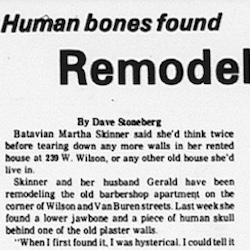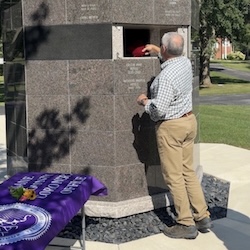Summary
 In November 1978, property owners found a human skull while remodeling a residence on Wilson Street in Batavia, Illinois. Batavia is located in the greater Chicago metropolitan area. The resident advised police that a bone had fallen from within the wall while removing a baseboard. The following day, the Batavia Police Department conducted a search to determine if additional remains could be found. The search yield no additional findings.
In November 1978, property owners found a human skull while remodeling a residence on Wilson Street in Batavia, Illinois. Batavia is located in the greater Chicago metropolitan area. The resident advised police that a bone had fallen from within the wall while removing a baseboard. The following day, the Batavia Police Department conducted a search to determine if additional remains could be found. The search yield no additional findings.
The individual’s remains were sent to the anthropology department at Northern Illinois University in DeKalb, Illinois where it was determined that they were that of a female who was estimated to be in her mid-twenties at the time of her death. It was determined that the person likely died prior to 1900. The skull was entrusted to the Batavia Depot Museum for storage. In 2021, the museum provided the skull to Batavia Police, launching a renewed investigation to understand the identity of the woman. Details of the case were entered into the National Missing and Unidentified Persons System (NamUs) as UP90186.
The Cold Case Team with the Kane County Coroner's Office pursued multiple leads in hopes of identifying the woman. As part of their efforts, the team contacted Othram to determine if advanced DNA testing could help to identify the woman. In 2023, the Kane County Coroner’s Office submitted forensic evidence to Othram in The Woodlands, Texas where scientists successfully developed a DNA extract from the forensic evidence. Othram then used Forensic-Grade Genome Sequencing® to build a comprehensive DNA profile for the unknown woman. Othram’s in-house forensic genetic genealogy team used this profile to conduct genealogy research, ultimately providing new investigative leads to law enforcement.
Using this new information, a follow-up investigation was conducted, leading investigators to potential relatives of the woman. Reference DNA samples were collected from the woman's potential second-great-grandson. Using KinSNP® Rapid Relationship Testing, the profile of the possible relative was compared to the DNA profile of the unknown woman. The investigation, paired with comparison testing provided by Othram, led to the positive identification of the woman, who is now known to be Esther Ann Granger,
Esther was one of six children. She was born nearly 176 years ago on October 26, 1848. Investigators believe that, at the age of 17, Esther died due to complications of childbirth in 1866. Although Granger was originally buried in Lake County, Indiana, two possible scenarios explain why her skull was found in a Batavia home. Investigators beliveve that her grave was robbed or her remains were used by a physicians as a scientific specimen, a common practice at the time of Esther's death. After Esther's identification, a composite sketch was developed depicting how she likely looked during her life. A private ceremony was held at West Batavia Cemetery, where Esther's remains were reinterred, finally closing a decades-old mystery that spanning three centuries.
 A DNASolves® crowdfund campaign was established to cover the costs of Othram's testing and investigative research. The Kane County Coroner's Office and Batavia Police department contributed seed funds to the campaign. Othram appreciates those who contributed to the crowdfund so that the team could assist law enforcement in identifying Esther. With Esther Granger having been born in 1848, this is the oldest unidentified human remains case worked by Othram to-date as well as one of the oldest individuals to be identified using forensic genetic genealogy.
A DNASolves® crowdfund campaign was established to cover the costs of Othram's testing and investigative research. The Kane County Coroner's Office and Batavia Police department contributed seed funds to the campaign. Othram appreciates those who contributed to the crowdfund so that the team could assist law enforcement in identifying Esther. With Esther Granger having been born in 1848, this is the oldest unidentified human remains case worked by Othram to-date as well as one of the oldest individuals to be identified using forensic genetic genealogy.
The identification of Esther Ann Granger represents the ninth case in the State of Illinois where officials have publicly identified an individual using technology developed by Othram. To read about other cases in Illinois that have been solved, visit DNASolves.
